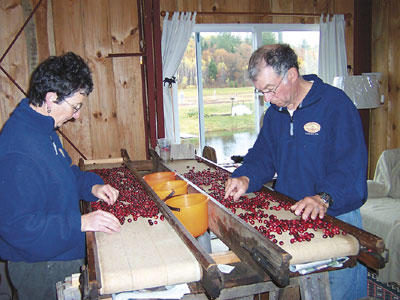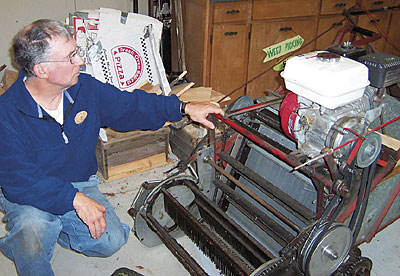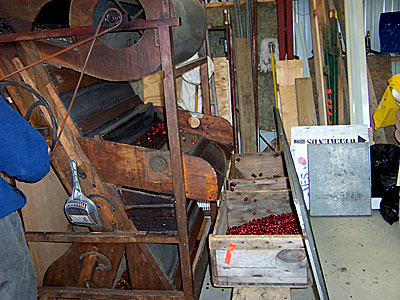 |
| After their organic cranberries have gone through a sorter, Rick and Linda hand sort the fruits for color, size and firmness. |
by Joyce White
You don’t need to wait for Nature to establish a cranberry planting: You can create your own cranberry farm from scratch! Richmond and Linda Woodward have done just that on land in Albany Township in western Maine. But it’s not necessarily easy. Or cheap.
Though still living in Stoughton, Massachusetts, Rick said they had originally planned to retire to Maine. They hit upon growing cranberries as a source of income because Rick had acquired some knowledge of the process while working for a man who was building cranberry bogs on Cape Cod. Then, with two years of hands-on experience working at a cranberry bog in Stoughton, he and Linda launched their own cranberry operation in 1994 – when the price was high, he added, with a rueful smile. Payback is a long-term process, and as more people began growing cranberries in the ‘90s, the price declined, he commented.
Growing organic cranberries (Vaccinium macrocarpon) is very much a joint venture for these high school sweethearts who have been married for 39 years, Linda said. Both have full-time jobs – Rick in construction, Linda as a dental hygienist – and they drive to Maine to work with the cranberries most weekends from April through November. Before building their work shed with small living quarters, they spent their Maine weekends in a trailer beside the farm pond.
 |
| Rick inspects the picker daily after its use for broken or misaligned teeth that need to be repaired before the next day’s work. |
Preparing for Planting
That pond is integral to the operation. Cranberries need dependable moisture – about 1 1/2 inches of water a week – but too much water fosters disease. They don’t grow well directly in water and can’t get pollinated if the plants are under water during late spring and early summer. The pond and irrigation system help balance these factors.
The 10-acre plot the Woodwards bought had been clearcut 10 years previously, but they had to clear the land, dig the pond, grade around it and get loads of sand spread as a planting medium. Cranberries do best with 8 to 18 inches of sand, but their berries will grow in less. The clay base of their spring-fed pond provides an impervious barrier to hold water. Before the Woodwards could begin planting, a sprinkler/ irrigation system had to be installed and buried.
During that first spring, though, persistent rains prevented getting bulldozers on the land early enough, so planting that should have begun in May didn’t begin until “the hottest day in July,” resulting in numerous lost plants.
 |
| This hand-powered, antique separator grades out bad cranberries, stones and leaves and is about 85 percent effective. |
Soil Fertility
Cranberries grow in acidic soil, as does moss, which is becoming a problem, Linda said. They hope that improved drainage will help mitigate the moss problem. They are also experimenting with sulfur to combat the moss.
The plants aren’t heavy feeders, Rick said, but they do better with a good organic fertilizer. They used to use fish emulsion but, because the nutrients in it were not well balanced for cranberry growth, they’ve switched to a timed-release lawn fertilizer, Renaissance, made from feathers and soybeans, which they apply once a year. The phosphorus in the fertilizer aids in root development.
Pests
Cranberry fruit worms have been a problem. The Woodwards apply Thuricide, a Bt insecticide, to control the pest, but 2008 was such a rainy season that much of it washed off. Rick estimates that they lost 50 to 70 percent of their 2008 crop to fruit worms. Still, with backgrounds in organic philosophy and gardening, the Woodwards are committed to a small organic cranberry farm, which can take a bit longer to produce a first crop, Rick said. Conventional cranberry growers using herbicides, insecticides and fungicides can get a crop faster with better yield, he added.
Planting – Vines or Plugs
The Woodwards grow cold tolerant ‘Howes,’ a slow-growing cultivar that takes two to five years to produce a first crop. The minimum planting rate is 2 tons of vines per acre, and planting stock costs from around $8,000 to $15,000 per ton, Rick said. The vines often come in bales about the size of a bale of hay. The bales must be kept moist and planted as soon as possible after they arrive.
At planting time, the purchased vines are spread by hand over the area to be planted, and then the Woodwards drive a machine with dull tines over the vines, which pokes them into the sand. A roller on the rear of the machine also helps push the new vines into the ground.
“The machine we used was a homemade contraption, which was self-propelled,” Rick said. He calls it an antique.
“Then they take off – supposedly,” Linda said with a wry smile indicating that it doesn’t always happen quite that way. If bare areas appear where plants failed to grow, they can plant more vines or train runners from existing plants to fill the bare spots.
Starting a new cranberry planting now can be much simpler and more sophisticated – but more expensive, Rick said – with the advent of pre-planted plugs that just go into the sand. Plugs produce a quicker harvest but cost substantially more and require more labor.
Hand Weeding
Cranberries are a bog plant, Linda explained, “so we get all the bog weeds – barn grass, rushes, reeds, switch grass. They all grow very well. We had a super-abundance of weeds this year, including goldenrod. Lots of rain makes them all grow better.”
Anything that spreads underground, she said, has to be pulled out by the roots. They weed by hand, carefully, to avoid dislodging the cranberry plants. Once the plants begin to flower, the Woodwards stop weeding until the berries begin to form. Then the weeding process begins again and continues until berries begin to ripen – when the Woodwards take another break from weeding because the berries fall off easily at this stage.
Frost Protection
As cranberries grow, their cold-tolerance changes. Buds that get frosted don’t produce berries, Rick said. Early in the season, before they begin to color, temperatures of 32 to 35 F can damage them. After they color, though, they lose some of their moisture content and then tolerate temperatures as low as 22 to 25 F.
In the cranberry-growing areas of Massachusetts, Rick said a system is in place to alert growers when a frost is predicted. “We have almost the same ripening pattern here as on the Cape, so we use that information.” But they can’t do much if they’re in Massachusetts when an early frost hits their bog in Albany. If they are in Maine, turning on the sprinklers may prevent damage.
Harvesting and Sorting
Harvest begins when most of the cranberries take on their characteristic ruby red hue, sometime in early October. They use two self-propelled, 40- to 50-year-old mechanical harvesters. Rotating fingers on the machines comb the vines and pluck the berries, and “squeegies” act like a conveyor and move the berries into a box. Rick checks the pins every night, since they sometimes break. “So many things can go wrong with all those gears, belts and chains,” said Rick. With so many moving parts and tension-regulating devices, the machines require a lot of maintenance and repair.
Five percent of the easily-bruised crop may be lost to damage from the mechanical harvester. In their first year, the Woodwards estimate that the loss was closer to 50 percent.
A lot of sand ends up in the box with the berries, Linda said. They used to shake the boxes to remove some of it. Then Rick designed a winnowing machine that takes berries in at the top and runs them through a slotted pocket – made from shelves from a discarded fridge – that removes the vines. The berries fall down an incline with a fan below. Sand and small stones fall through to the next level, while relatively clean berries fall into the box.
The next addition to their arsenal of cranberry cleaning devices in the barn is a separator, which came from a museum. Rick explains that a cranberry grower of old stored his harvest on the top floor of his barn just as they came from the bog, cleaning them only as needed. One day as he was bringing a box down the stairs to be cleaned for use, he dropped the whole box. The soft berries stayed on the stair treads while the good ones bounced to the bottom of the stairway
That observation led to the creation of the separator. Using the principle that unusable berries fall to the bottom, the separator has a series of ladders, rather like fish ladders, he said. After berries are poured in at the top, the good berries bounce over the ladders and into the collecting boxes, while bad berries fall behind the ladders to the bottom on the separator.
Some markets will take berries as they come out of the separator, but these will still include an occasional small stone or soft or unripe berry. Other markets require a further sorting step, which the Woodwards were doing by hand when I talked with them in late October. With a woodstove heating the cozy living space behind the work area, they worked together, one on either side of a long narrow sorting table, talking as they methodically removed any further debris or undesirable berries.
Linda explained that berries need to be picked under dry conditions, which usually means they can’t begin harvest until about 1 p.m., because the dew of late fall stays on the ground until nearly noon. It begins to roll in again by 4 p.m., creating a short harvest window. They usually take the whole week of October 12 off from work at their jobs to concentrate on the harvest.
In commercial cranberry processing plants, Linda said, women sit at long tables for eight weeks sorting berries, just as the Woodwards were doing on that October Sunday. Commercial processors use wet-picked berries for any cranberry product that will be cooked – juice or jelly, mainly – because wet berries won’t keep. Dry-picked ones are for fresh market and will keep from three to five months in a cool place.
Marketing: PYO and More
Woodward Cranberry Farm offers PYO berries a few weekends in October. Linda said that she or Rick picks alongside a PYO customer to help educate them about cranberries. They sell packaged or bulk berries to local customers and to organic suppliers. Linda offers samples of cranberry muffins and squares along with recipes to farm visitors.
As organic growers, the Woodwards aim to avoid polluting the environment with toxic chemicals. They have 2 acres in production, and Linda said they’re lucky to get 1,000 pounds per acre. “It depends on how many worms we can stop and how many weeds we can get out,” she said. [According to David Handley and Charles Armstrong (see Resources), “Well-managed bogs should produce 100 to 200 barrels of cranberries per acre, each barrel weighing 100 pounds.” The mean yield in Maine in 2008 was 11,756 pounds per acre, according to figures at www.umaine.edu/umext/cranberries/harvest.htm. Rick says that organic growers in Maine get about 4000 pounds per acre.]
Resources
Woodward Cranberry Farm,
781-344-4818; Cell 781-771-6192; [email protected];
www.woodwardcranberryfarm.com.
“Commercial Cranberry Production in Maine: An Introduction,” Bulletin #2247, by David Handley, updated by Charles Armstrong, Extension cranberry professional, 2003; www.umext.maine.edu/onlinepubs/htmpubs/2247.htm
Charles Armstrong 207-581-2940, [email protected]
“Overview of Organic Cranberry Production,” by Eric Zeldin, 2008; Dept. of Horticulture, University of Wisconsin-Madison; www.cias.wisc.edu/wp-content/uploads/2008/07/orgcran.pdf.
“Growing Information,” by John Harker, Debra Parry, 905 Sandy River Rd., Mt. Vernon, Me. 04352; 207-293-2356; www.cranberrycreations.com. Planting information for home gardeners; plants for sale
“Establishing an Upland Cranberry Bed in Maine,” by Charles Armstrong, www.umaine.edu/umext/cranberries/growing.htm
“Cranberry Agriculture in Maine,” www.umaine.edu/umext/cranberries/default.htm
Fedco Trees, www.fedcoseeds.com/trees.htm – rooted plants.
Hartmann’s Plant Co., Lacota, Michigan. www.hartmannsplantcompany.com, 269-253-4281 – plants and plugs
